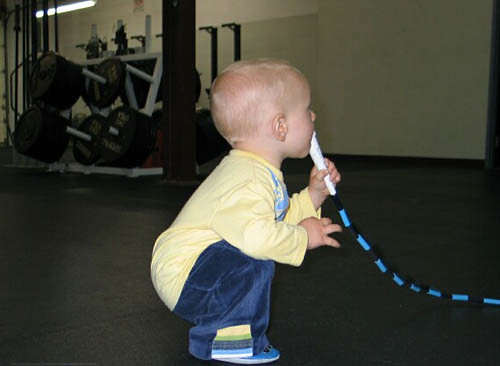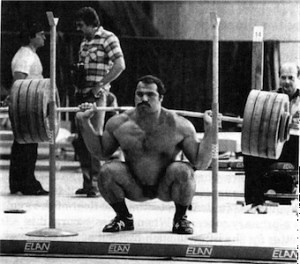[This guest post was written by my amazingly smart and talented husband. He taught me everything I know about lifting. Please take the time to read what he has to say. It is a bit long, but provides important safety information that could not be omitted.]
When it comes to getting the most bang for your training buck, it doesn't
get better than squats. People have been scared away from the squat
rack for years because of misinformation, either regarding possible health
concerns from squats, or confusion and conflicting information about form.
This confusion makes sense on a certain
level, because the squat can be a complex movement to perform, and if performed
wrong there is in fact the potential for injury. But with
the right resources you can use squats to SAFELY improve your strength.
Many have argued that
the squat is not a safe or natural movement. If you are concerned, simply watch any young child pick something up off the ground. Perfect squat form!
 | ||
| Photo by of willsansbury via Flickr |
 |
| Photo by CrossFit Chicago, via Flickr |
You may have trouble with squats at first. Humans
are meant to be able to squat down to the ground. Instead we spend all day sitting in chairs and never walking more than 10
feet without requiring some form of transportation. The
result is that our hips and hamstrings tighten up as we age, to a point where
squatting seems as foreign to us as, well, running. Or jumping. Or anything we're supposed to be
able to do but can't anymore because we're lazy.
If you watch an Olympic weightlifter and
a powerlifter squat next to each other you'll probably notice a lot of differences. Some prefer to keep
their stance at shoulder width, while others prefer to place their feet much
wider apart. Some hold the bar a
little higher on their back, while others hold the bar a bit lower.
The only real limitation as far as where you hold the bar on your
back is that if you get too high, you'll find that the bar starts to sit on
your spine, which is definitely something to avoid. The bar should always be on muscle as you
hold it.
Olympic lifters:
 | |
| Photo: CrossFit Chicago via Flickr. |
 |
| Photo: Maloney Performance |
Powerlifters:
 |
| Photo: Ironman Magazine |
 |
| Photo: CrossFit Oakland |
WHAT TO DO WITH YOUR BACK, KNEES, AND BUTT
Now
let's look at what all of these strong people are doing the same. They all push
their knees OUT to the sides as they squat down. You
may find while squatting that as you start to push yourself back up your knees
start to come in towards each other. This is a big no-no. Push your
knees out hard as you complete the entire lift. It may help to think of trying
to push the floor apart under you with your feet. As your hips get stronger, your knees will stay out on their own.
Another thing you'll see in the pictures is that the back is arched and
the butt sticks out. A slightly arched back can hold more weight than one
without an arch, and keeping an arch in your back will also tighten your core
muscles and protect you as you begin to lift heavier weights.
In the end, there are
2 simple thoughts that you need to keep in mind while squatting -- butt back, knees out. Start the lift by
sticking your butt back like you’re trying to sit on the toilet, then push your
knees out as if you have a gut and you need to make "room" for it
between your legs as you squat down.
HOW DEEP SHOULD I GO?
One thing is for sure;
almost everyone you see squatting at your local gym isn't going deep enough. The general rule for good depth is that you
should go down to parallel. For our purposes, parallel means that the hip is at
the same height as the top of the knee, resulting in the upper thigh being
parallel to the ground. Focus on stretching every day, as
well as keeping your knees out and butt back, and go as deep as you can. Eventually
you'll find that you can reach parallel with no problems. If you want to get the most out of squats, there's nothing wrong with
going even deeper than parallel.
So, if our goal is to go as deep as possible, when do we know that we
are going too far? Well, as you descend, eventually you'll
reach a point where you lose the arch in your lower back and your butt begins
to tuck under. This is known as "butt wink" in the lifting world, and
it should be avoided. Do your best to stop just shy of this point, and you
should be getting great depth in your squats.
DON'T be afraid to go
deep. It's more effective to take a
lighter weight and squat it deep with good form than to throw a ton of weight
on your back and do half reps. In fact, this tendency to do super heavy
half-squats is the main reason why squats got such a horrible reputation. When
you stop half way down all of the pressure is put on the tendons on the front
of the knee as you stop and change direction. If, on the other hand, you descend as far as possible, the pressure is
evenly distributed throughout the entire structure of the knee. This leads to a
healthy, strong knee that will allow you to be more active throughout your
life.
HOW MANY REPS SHOULD I DO?
So now that we know
how to perform a squat, the only thing left to figure out is just how many
squats we need to do. My suggestion to you is the keep your sets of squats at
3-8 reps. I know, this goes against most advice you'll get. Magazines will all
tell you to do higher reps for "toning". Let’s talk about toning; it
doesn't exist.
4 things can happen when you exercise:
1. Your muscles get bigger.
2. Your muscles get smaller.
3. You lose fat.
4. You gain fat.
I understand that it probably
isn't your goal to get "big". Don't worry. Getting huge muscles
doesn't happen accidentally. It takes years of effort with a focus on gaining
size to get huge muscles, if it happens at all. Instead, what people usually refer to as "toning" is a combination of
gaining a little muscle size while losing some fat. So don't be afraid to gain
a little muscle size. This is part of the reason why I suggest lower reps
per set compared with most conventional, fitness magazine-style advice.
Another reason to keep your reps
lower per set is that you should NOT be
going to failure with squats. This will lead to a severe breakdown in form that
could lead to injury. The third, final, and most important reason I suggest
lower reps is that it is MUCH easier to
keep good form if you keep your reps under 10. You're going to get better
results from 6 sets of 5 than you will from 3 sets of 10, because you'll be
able to use a little more weight with better form, even though you'll end up
doing the same number of reps.
Take Home Points
- Keep the bar on muscle, not bone.
- Start the squat by sticking out your butt, then descend by pushing your knees out to the side.
- Go deep, but not so deep that your butt tucks under.
- Keep your reps at 3-8 per set.
- Keep your form tight.
- Don't push yourself to failure.
Squats can be the
biggest weapon in your exercise arsenal. They can reshape your butt and thighs
into statuesque hunks of gorgeous Greek granite, and make your joints so
healthy that you may be able to do super human feats, such as picking up a pen
from the ground without having to hold onto a chair or table. Do you really
need any more coaxing? Get to it!


I am so jealous that my daughter can squat with her feet flat. Although I am very flexible (I can still do a backbend), I am still working on squatting!
ReplyDeleteLove all the photo examples in this post.
ReplyDeleteOmg! Those first few cracked me up! ;) My daughters can definitely squat better than me. Great info!
ReplyDeleteThanks for the tips, especially about pushing knees outward- I think that one will help my form a lot. (although I'm usually doing low weight with more reps. Not your style, I know!)
ReplyDelete